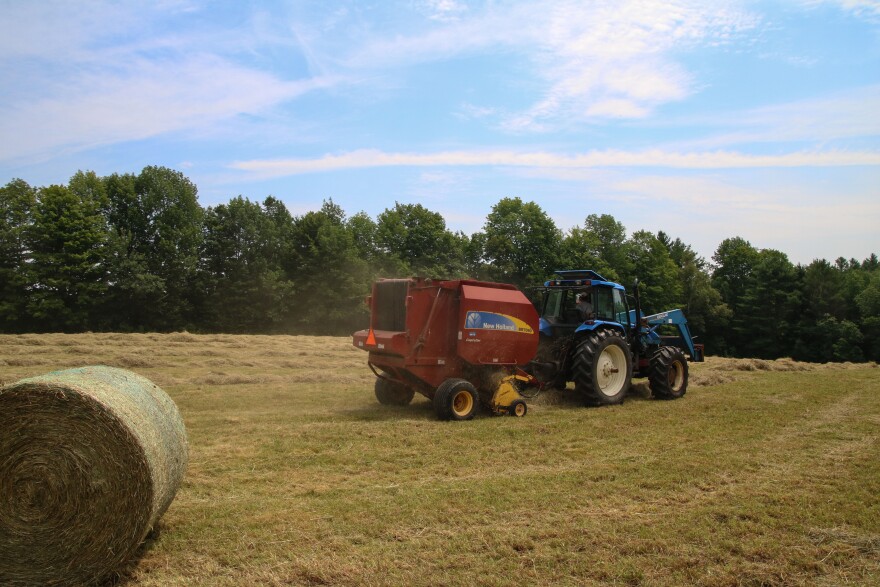On a bright July day, Laura Lecker is standing next to a hay field in Penobscot. She’s about to walk out into the tall grass to make sure that fledgling bobolinks and other grass-nesting birds are able to fly.
“Our job is to go out and check to see that the birds are flighted enough to get out of the way of the mower," she says.
The birds she’s most interested in are bobolinks and Savannah sparrows, both of which are known to nest in this field.
“What I’m going to do is take my little flushing stick and walk out and see," Lecker says. "What I’m looking for is to see if anybody is still guarding their territory, if I’m getting yelled at by any birds. If I don’t see that, which I don’t expect that I will today, then this field will be clear for Ben to go ahead and mow whenever he’s ready.”

Lecker is the founder of Ag Allies, a new field management program in Maine that aims to help protect young nesting birds. Birds that nest in grasslands are in decline nationwide, facing challenges including seasonal changes brought by climate change, including earlier harvests of hayfields.
Farmer Ben Gifford cuts hay for this landowner.
“This is my tenth year in this field," he says. "I know this field rather well. ”
He says the hay is in good shape, despite the recent dry weather. He points to the bright purple clover heads that are a sign of good quality, but he notes that some are starting to dry out.

“You can see the difference with the nice purple bloom of the clover, which is what the farmer wants before the whole field ends up with the brown heads like this, which is starting to happen now," he says. "And that’s why a lot of farmers start haying earlier and disturb the birds, because they want a lot of purple and not so much of this.”
This is Gifford’s first year managing the field under the guidance of Ag Allies, which grew from Lecker’s work with the Somerset County Soil and Water Conservation District and her love of birds. She says it all started when she was discussing a nutrient management plan with a farmer in Ripley.
“We were out there talking and there were bobolinks everywhere," Lecker says. "And I said, ‘Do you know that you have bobolinks out here?’ and he said, ‘What’s a bobolink?’ So I dragged him over to the field and said ‘Look this is great,’ and I started telling him about the birds.”

And there’s lots to tell. Bobolinks are ground-nesting birds with a remarkable migration that takes them to wintering areas as far away as Paraguay and Argentina.
“The males are gorgeous, and their coloring is described as a reverse tuxedo, so they are black in the front and black and white in the back," Lecker says, "And then they have what looks like a yellow yarmulke that’s slipped kind of off to the back of their head. And their song sounds exactly like a melodic R2D2.”
Lecker calls it the sound of joy. But that song is becoming less common in the U.S. as bobolinks, like many grassland birds, are in decline. The primary cause is the loss of habitat, and changing agricultural practices, some linked to climate. As temperatures warm, some data show that hay is maturing earlier in the Northeast, prompting some farmers to start baling hay earlier than in years past, before grassland birds have fledged.
On a dry July day, Tom Johnston is baling hay on a field in Montville. Many other hay fields in Maine have already had two cuttings this year, but because this field is managed under the Ag Allies program, the first cutting must wait until the nesting birds are ready to leave the protection of the long grass, usually by mid-July. Johnston says the timing is yet another variable in the ever-changing haying season.

“If we have a cold, wet spring, it’s gonna push the crop back," Johnston says. "And last year was dry early and then wet through July. This year was wet early, heat, then we got cold again, and they’re talking cool again next week?"
Ag Allies offers incentive payments to some farmers to compensate for any loss in hay quality due to a delayed harvest. The program has grown from just 2 farms in 2016, to more than 50 this year, and 1,100 acres. Of those, about half take incentive payments, while others just want guidance about protecting birds.
Back in Penobscot, as Lecker makes her way through the field, she sees no sign of bobolinks, until she encounters a large group in a swale next to the hay field.
“Yep, there’s a female," Lecker says. "OK, now I hear you guys. She’s not really happy that we’re here.”
The juveniles are flying well, so Lecker gives Gifford the go ahead to cut the field. Before long, the bobolinks will be winging back to South America. And Lecker says she'll be working to ensure that they’ll find plenty of nesting habitat on Maine farms when they return next spring.




